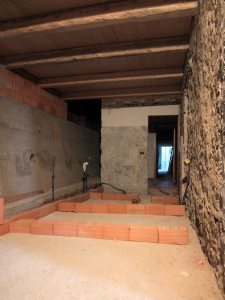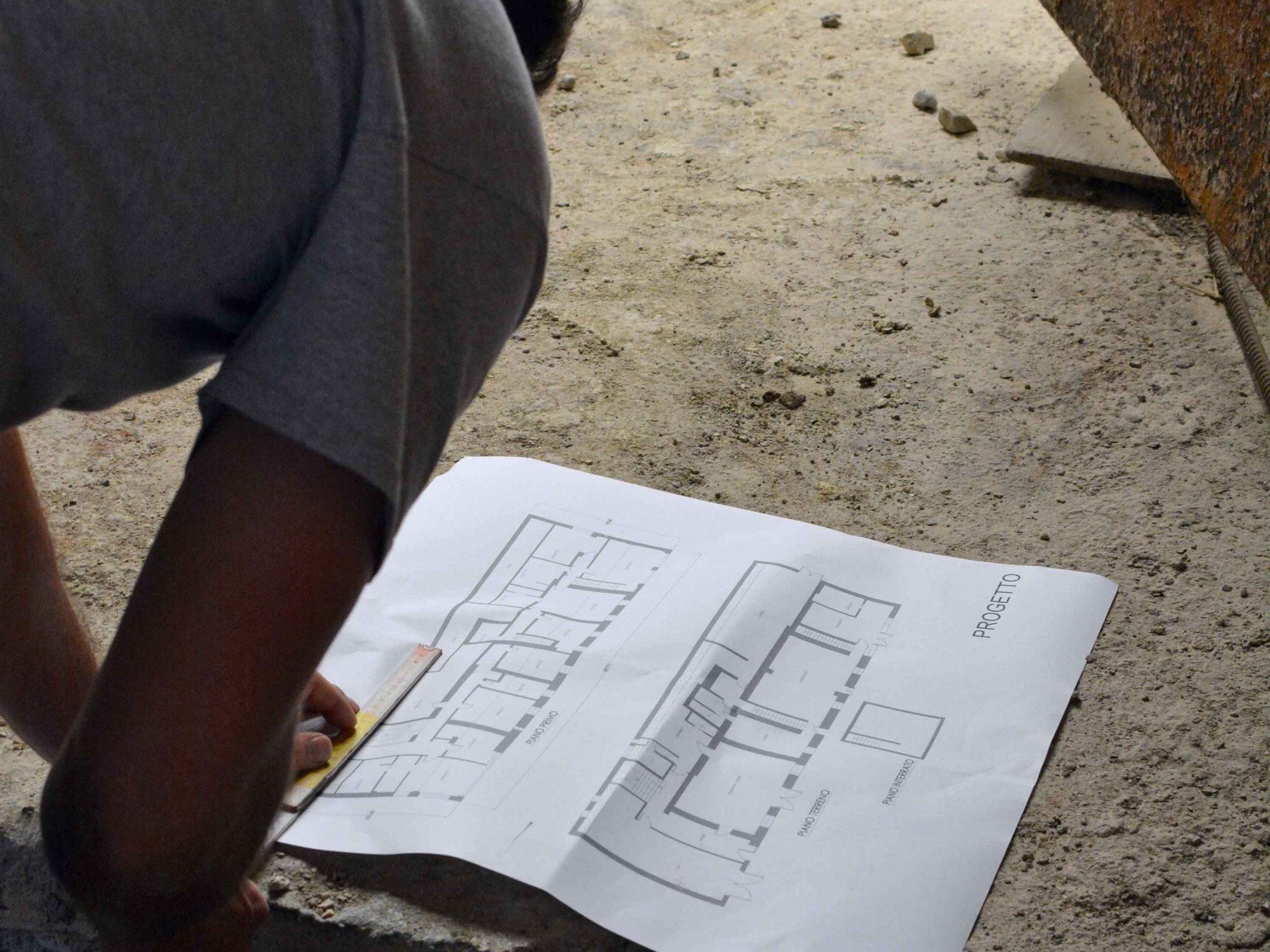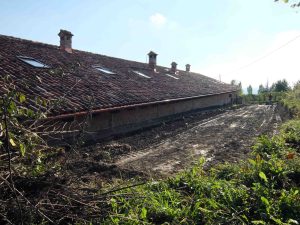It had to happen eventually. After five months of relatively pain-free renovating we’ve finally hit a bump in the road. Or, more accurately, a huge hole in the road.
I’ll try to explain…
Our house is built on a hill, and the back wall is half underground. That’s not a problem though because that back wall is a huge, reinforced concrete wall that holds back the earth, provides good insulation and lets the water drain through and into the well.
We decided to pretty much leave this wall well alone, after all it’s doing a good job. However, from the outside, where we’re putting in an access road, we decided to dig down a bit further to put in a waterproof layer and some drainage, so as to take a bit of water away.

But in digging down we made a rather surprising discovery. This huge, concrete behemoth is in fact no more than clay and a few stones with a one-centimetre coating of concrete. It turns out that much like a book, you should never judge a wall by its cover. If Hollywood were to build a concrete wall, it would be this one.
This is a problem. A big problem. The whole back wall of the house is supported by nothing more than clay, and if I remember rightly the song we sang in Sunday school was not about the wise man who built his house on clay.
So, we have to do something to fill this wall in, to turn it into an actual wall. It’s going to take concrete and some engineering know-how, neither of which I possess, so there is an engineer at the house this morning attempting to come up with a plan. I’m just hoping and praying that there is a simple solution.
Meanwhile I’m going to continue puzzling over why on earth anyone would go to the effort of building a fake concrete wall…


may i suggest an eco solution like tires, cob or straw bale….. and yes they will serve as a support walk. cheaper and quicker.
good luck
Cool, thanks for the advice, I’ll talk to the engineer about it later. I’m always up for an eco solution, particularly if it saves us money!
That really is a mystery. And a bit of a scary surprise. Good thing you discovered it so early on!
It’s got everybody scratching their heads… nobody has seen anything like it before. Maybe we’re going to discover some secret passageway hidden behind the false wall. Or gold… lots of gold hidden behind there!
Or ancient wine!
Oh, flip. Rats. And all those other expletives that won’t shock anyone. The only explanation is that your house wall was built before the hill decided to shack up behind it. Otherwise, there’s a possibility that someone just slapped concrete on top to make a traditional wall look more reassuring. Joking apart, surely the oldies who built the house knew what they were doing? Maybe I am too confident in traditional house building.
Thanks for the gentle expletives MM! I’m a firm believer that they must have known what they were doing. In any case, the house has been pretty solid for a long time, so whatever they did it clearly worked. I think they must have just wanted it to look nice and solid, that’s the only explanation I can come up with!
Oh no! How frustrating, let’s hope the engineer can come up with a solution that isn’t too costly, and which doesn’t include underpinning and you avoid the usual red tape. Good luck with your fab renovation, once it is all done and you and your guests are enjoying the property, you won’t remember all the set-backs.
Thanks Maureen! There’s a bit more digging to do to found exactly what we’re dealing with, but so far it looks like a bit of shoring up and filling in is going to be needed. The engineer seems happy enough with the plan as it stands so just as long as we don’t discover anything else it ‘might’ not be too bad. We’ll see….
It’s a pain but you’ve discovered it at the right time. And are bringing in the experts now to deal with it. Re the comment about red tape, if Italy is anything like here in France (probably so) you won’t have to have each stage of the building “signed off” by Building Regs as required in the UK, which would hold the process up. Good luck with your build, it’s so interesting!
Thanks Ann! You’re right, it’s kind of reassuring to have discovered it I guess. Had we not found it then we may have had problems a few years down the line, which would have been far worse. It’s been a real surprise to everyone though. I’ve never seen so much head scratching!
And no, you’re right, there shouldn’t be a red tape problem. The engineer has to be happy with everything so as long as we follow his recommendations we should be fine.
They probably had a Latvian builder – it looked alright on the surface and it was cheaper so… 😉
Hope there’s an easy fix!
Well, it definitely wasn’t a German builder… 😉
Nothing would get through that sucker if it had been 😉
Ha ha! Always hire a German…
These people WORK!
Latvian builder! Linda is always so funny!
I try my best 😉
Oh dear, hope the solution isn’t too complicated!
Thank you… me too!!
Oh my life !!!!!! I think I will go and test all our walls, knowing my luck some of them will be made from Plasticine.
Ha ha… at least plasticine is fun!
I would think that the original survey or geometra should have discovered this as part of the work they were paid for and they should be somewhat responsible or at least made to feel bad about it ??? Also the Architects should have looked at the entire building, unless they specifically mentioned that they were not looking into that area? We had a similar thing come up and the solution did involve digging / canal draining and lots of concrete and special glue, unfortunately. There was never even any apology. All we got was, “this is Italy…..Quest’ è Italia” Silicone does seem to be the other solution for everything in Italy, but I do not think this would work in your situation.
I think, sadly, it’s just one of those things we have to accept. One side of the wall is visible and is solid-looking concrete. Given it’s shape and position, as far as anyone could tell, it was a large concrete wall. There was no reason for anyone to believe otherwise and no reason for the wall to be there if it wasn’t indeed concrete. We’ve only discovered it isn’t by digging out hundreds of tonnes of earth from behind. I guess someone could have drilled into the wall to check it was concrete the whole way through but I’ve never known a surveyor or architect do that. I’d like to blame someone, but I think, sadly, we’ll just have to take it on the chin.
My guess is that, assuming this was originally a farm building, the then owner used a grant for something else instead of the designated wall. Or a bloody builder did this on the sly when the owner wasn’t watching. Don’t you just hate it when these things happen? Good luck my friend….
I think you might have hit the nail on the head there June… trust someone who lives in Italy to have figured it out! Get the grant, make it look like you’ve built the wall, spend the money on something far less important! We were kind of expecting the unexpected, but this wasn’t the unexpected we were expecting, if that makes sense!? The one thing we had faith in was the huge concrete wall!
The back bottom half of our house is similar and built into the hillside, when we removed the white plaster to discover the ancient stone walls we were please as they can now breathe and we got rid of the smell of damp. However when we were working we came across a false wall built just 6 inches away from the original, it’s purpose was perplexing, unless it was used to wall up a very skinny partisan during the revolution
You never know what you’re going to uncover in an Italian house it seems… fake walls are clearly a favourite!
What happened? Just reading through the comments – dodgy stuff indeed. Is it a huge hassle in the end??
Well… we got two engineers out to look at it because the builders thought the first one was too negative. They both said pretty much the same thing though. We have to dig the wall out in one metre sections and then back-fill it with a special type of concrete. It’s going to cost a lot but it has to be done. I’ve seen enough Grand Designs to have expected some kind of problem, and we had a contingency fund. It’s mostly gone now though so fingers crossed for no more big problems!
Fingers crossed!
What a headache…a headache! I can only hope that you will find a solution to this unwanted surprise without having to suffer too many headaches. Ouch.
Thanks Rowena! The headaches on this one are the engineer’s problem (it’s way out of my league…), it’s the budgetary aches that are really going to hurt! We’ll get it sorted though.